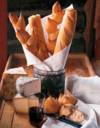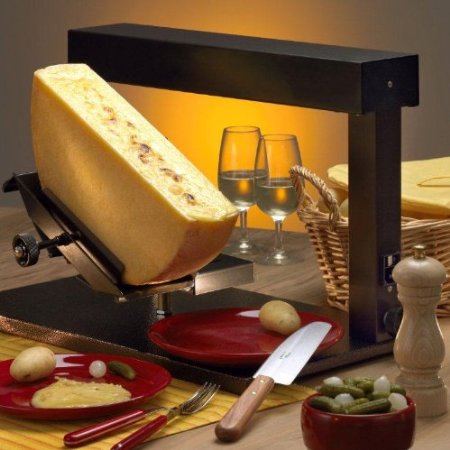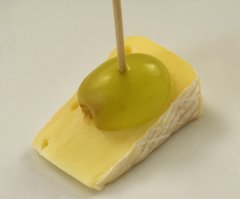The Ultimate French Cheese Course!
And Other Ideas for
Elegant Entertaining with Cheese
in the French Style
In France a proper French Cheese Course is often served at the end of the meal, instead of dessert. Here in the U.S. we rarely host such formal dinners with many courses. So we are most likely to find a cheese course at a 4 Star restaurant. In New York City, at the renowned Picholine restaurant founded by Max McCalman and Terrance Brennan, 3/4 of the dinner guests order a cheese course as part of their meal. Picholine, boasting a glass-doored cheese cellar in its private dining room, became such a success that McCalman and Brennan subsequently opened Artisanal, a restaurant in NYC focused on cheese.
Artisanal offers 250 cheeses, happily resting and ripening in the state-of-the-art, walk-in cheese cave which has 5 different climate zones to accomodate the varying temperature needs of the special cheeses, imported from all over the world - and of course including many artisanal cheeses from American cheesemakers.

If you are in NYC you owe yourself a treat - make a reservation and indulge your passion for fine, gourmet cheese. By the way, Max McCalman is probably the top cheese expert, the top Maître Fromager in the U.S.. He has written many books on cheese and teaches classes on cheese at the Cheese Institute and at Artisanal.
Take a good look below at the chart for a French Cheese Course. It is divided into 4 groups, based on the idea of a Cheese Clock. Beginning with Group 1 (let's place it at 6-9 pm on a clock), the progression moves from simple on up to complex (Groups 3 and 4) - from young cheeses to more aged cheeses - from mild flavor to strong flavor - and ending with the Blues in Group 4. So Group 2 will be at 9 to noon on the clock; Group 3 will be at noon to 3 pm on the clock and Group 4 will be at 3 to 6 pm on the clock.
Depending on the type of party and number of guests, you will select 1-2 cheeses from each group, along with 1-2 wines which are listed below with the cheeses they pair well with. Use this chart as a starting point, and as a reference later on, when you are more comfortable with your cheese and wine selections.
Start Your Gourmet Cheese Investigation Today
...
 |
Includes:
|
Click on the image above to order a sampler. Enjoy some fine Gourmet Cheeses today! -- G.C.D.
1st Group - Young, Mild Goat Cheeses; Bloomy Rinds; Double and Triple Crèmes
Select 1 or 2:
Brillat Savarin with Champagne or Sauvignon Blanc (Sancerre)
(Cow, Triple Crème, Bloomy Rind)
Pierre Robert with Champagne
(Cow, Triple Crème, Bloomy Rind)
Crottin de Chèvre with Sauvignon Blanc (Sancerre)
(Fresh Goat, soft, 10 days to 6 weeks aging)
Selles sur Cher with Sauvignon Blanc (Sancerre)
(Goat, semi soft, natural rind, 60+ days aging)
Valençay with Sauvignon Blanc (Sancerre)
(Fresh Goat, semi soft)
Brin d’Amour with Sauvignon Blanc (Sancerre)
(Sheep and/or Goat, semi soft, natural rind,
from Corsica, Herb Crusted)
2nd Group - Soft to Semi-Firm; Mild Cow, Aged Goat or Sheep
Select 1 or 2:
Brie de Meaux with Chardonnay or Gewürztraminer
(Cow, Bloomy Rind, Soft)
Abbaye de Belloc with Pinot Noir
(Sheep, Semi firm, natural rind)
Ossau-Iraty with Pouilly Fumé or Merlot
(Sheep, Semi firm, natural rind)
Cabecou Feuille with Chardonnay
(Goat, Soft, dipped in Plum Brandy, wrapped
in Chestnut Leaves)
Morbier with Red Rhône or Pinot Noir
(Cow, Semi soft, natural rind)
Chevrot with Sauvignon Blanc (Sancerre)
(Goat, Semi soft, Washed Rind, good starter Goat Cheese)
Entertain Like No One Else With an Authentic Raclette Warmer!
This set includes a raclette cheese holder, sturdy base and quartz light mechanism for melting cheese. The cheese holder swivels and slants downward, to scrape melted cheese, and accommodates either a half round or half square of raclette cheese.
Click on the link to order one today! - G.C.D.
3rd Group - Hard Mountain Cheeses; Washed Rinds; Stronger Flavors, Nuttier, More-Complex Nuances
Select 1 or 2:
Pont-l’Évêque with Calvados or Pinot Noir
(Cow, Washed Rind, “Stinky”)
Livarot with Calvados or Pinot Noir
(Cow, Washed Rind, “Stinky”)
Tomme de Savoie with Côtes du Rhône or Pinot Noir
(Cow, Semi soft to Semi firm, natural rind)
Abondance with Côtes du Rhône or Pinot Noir
(Cow, Firm, Washed Rind)
Saint Marcellin with Côtes du Rhône or Pinot Noir
(Cow, Soft, Bloomy Rind, packed in pottery crock)
Salers (Cantal Cheese Family) with Côtes du Rhône
(Cow, Semi firm, natural rind, Mountain Cheese)
Raclette with Côtes du Rhône or Pinot Noir
(Cow, Semi soft, brushed rind)
4th Group - The Blues
Select 1 or 2:
Roquefort (Carles is best brand) with Sauternes
(Sheep, Blue, natural rind, sharp, crumbly, moist)
Fourme d’Ambert with Sauternes
(Cow, Blue, natural rind, rich, less sharp)
Bleu d’Auvergne with Sauternes
(Cow, Blue, natural rind, rich, medium sharpness)
Organizing the Party
If you are planning a French Cheese Course party - as a stand-alone kind of party occasion without the appetizers, entrée, salad and dessert courses - this is what you do: Select 7-9 cheeses in all, 1-2 from each of the 4 Groups. Arrange your choices on a table in a clock formation - your dining room table, using attractive plates, platters, boards or trays. Group 1 will be the starting point for your French Cheese Course party and will be placed on 1/4 of your table. Moving clockwise, Group 2 will then be arranged on the next quarter, Group 3 on the 3rd quarter and Group 4 on the 4th quarter. Your Wine selections will be grouped with their Paired Cheeses. Plan on portion sizes of 1.5-2 oz of each cheese, for each guest. Use a separate knife for each cheese! It's a great idea to place cards with the cheese and wine names, types, region of origin, on the table. Small placecards work well for this. Most people don't have enough wine glasses to provide fresh glasses for each wine, for each guest. So it's perfectly okay to use the plastic wine glasses you can find in most wine shops, party stores and even supermarkets. Be sure to buy enough so that the guests can grab a fresh glass for each wine as they move around the table.
If you are planning a French Cheese Course at the end of a seated dinner, then select 3 cheeses
total: 1 from Group 1, 1 from Group 2 or 3, and 1 from Group 4. You
will want to pre-slice the cheeses and pre-arrange them on individual
dessert plates, along with the accompaniments you have chosen. You may
continue to serve the wine that you served with the main entrée - or, if
you are feeling generous - serve Champagne along with the cheeses. Plan on portion sizes of 1.5 oz of each cheese, for each guest. But if you found the perfect wedge of Carles Roquefort at the Cheese Shop - then by all means let it stand alone as the grand finale to your dinner, along with its perfect wine accompaniment - a bottle of Sauternes. Nothing else is needed!
If you are serving a Selection of Cheeses with Wines as Appetizers, either before dinner, or as a stand-alone informal occasion, then select 3 cheeses: 1 from Group 1, 1 from Group 2 and 1 from Group 3. You may want to select a Blue from Group 4, but I recommend that you skip the Blues if the cheese is being served before dinner. Set up a Cheese Board or Platter for the 3 cheeses and group your accompaniments around the cheeses.

Plan on portion sizes of 2-3 oz of each cheese, for each guest. Again, one knife per cheese, please. Wines are your preference. You may wish to serve only Champagne, or Prosecco (Italian sparkling wine) or Cava (Spanish sparkling wine), which work quite well with many cheeses. If there are a number of guests, then provide both Red and White Wines as per the chart above, along with or instead of, the Champagne or sparkling wine.
What About
Accompaniments? ... I hear you ask!
Here are some suggestions. Most gourmet food stores offer a wide selection of terrific condiments you can serve with your cheeses.
Buy the best French baguettes you can find - with crunchy crusts, not soft, wimpy crusts.


Or buy some artisanal hearty breads like Tuscan Boules, or Country Breads or Sourdough Breads, ideally from a bakery. Slice the baguettes and breads thinly. Plain crackers are fine, but breads are better! Common accompaniments to a cheese course are nuts, fruits such as thin sliced Fuji or Gala apples and Bosc pears, grapes, strawberries, dates and figs, cornichons (little French pickles).
Some great pairings for you to try with your French Cheese Course -
Double and Triple crème cheeses with walnut/raisin country bread or pecan/raisin bread.
Fresh Young Goat Chèvres with figs and specialty fruit chutneys like mango and ginger, drizzled honey.
Washed-Rind Cheeses like Pont-l'Évêque work well with a shallot confit.
Blue Cheeses with nuts, dried fruits like apricots and dates, fig marmalade, with walnut/raisin bread, even with thinly sliced red onion.
A variety of nuts such as walnuts, hazelnuts and almonds works with all cheeses.
Sheep Milk Cheeses with honey, good fruit preserves like Black Cherry.
Go to Wine and Cheese Party Menus from Around the World
Go from French Cheese Course to Entertaining - Cheese Courses
Go to Pairing French Cheeses with Wine
Go to French Cheeses A-L
Go to French Cheeses M-Z
HOME › French Cheese Course

Looking for something specific on GourmetCheeseDetective.com?
Enter your request below:
Follow The Gourmet Cheese Detective on Twitter: @The_Cheese_Tec
Do You Know About Cheese Papers?

Cheese Papers for beautiful wrappers and fresher cheeses. Use these elegant cheese papers to display, present and serve all of your fine Gourmet Cheeses at your next cheese tasting. Keep your cheeses fresh and your guests happy! Click on the image above to order cheese papers for your next cheese party! -G.C.D.
Enjoying All Things French
Mastering the Art of French Eating: Lessons in Food and Love from a Year in Paris by Ann Mah

The memoir of a young diplomat’s wife who must reinvent her dream of living in Paris - one dish at a time. Mastering the Art of French Eating
is interwoven with the lively characters Ann meets and the many traditional
recipes she samples. Both funny and intelligent, this is a story about
love—of food, family, and France. Francophiles unite! Click on the image to order your copy! - G.C.D.
Wish You Could Live Like Real World Travelers?

Dreaming of traveling the world enjoying Gourmet Cheeses in their native environs? Go on a global adventure from Irish Georgian mansions to windswept
coasts of Portugal, from Turkish bazaars to the contact sport of
Italian grocery shopping with Lynne and Tim Martin’s book, Home Sweet Anywhere. It is
a road map for anyone who dreams of turning the idea of life abroad into a
reality. Click the image above to order your copy today and begin your own explorations! - G.C.D.


